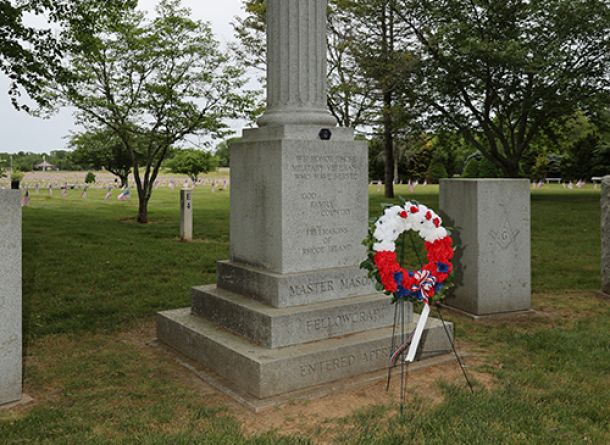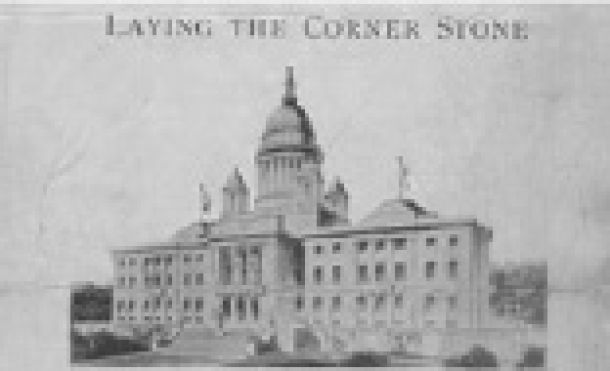Grand Lodge Heraldry Introduction
An introduction to Heraldry of the Rhode Island Grand Lodge, by R∴W∴ David Lavery
Castles in patterns and golden compasses. Shields with helmets aloft, adorned by fine cloth flowing in the wind. Exotic furs and tinctures reminiscent of luxurious accoutrements of medieval nobles. Beasts, both naturally majestic and many quite mythic, adorning all – these are the objects our modern eye fixates upon first with heraldry. We interpret these items through our own lens and at least appreciate their aesthetic value. But, have you asked what these devices mean or whence they derive? Perhaps you've noted that your lodge has some furniture with these elements displayed on it or perhaps within your lodge's seal: these are elements sometimes called a coat-of-arms or more properly an achievement of armorial bearings. These various artistic renderings of chivalric arms are but one aspect of "heraldry", which, as one of the auxiliary (or ancillary) sciences of history, is concerned with all matters relating to the responsibilities of Officers of Arms – known collectively as "Heralds". Over several brief articles, I hope to introduce you to some of the various uses of heraldry within Freemasonry.
 For brevity, let's only focus on the heraldic achievement used on the "livery flag" that we often see in the Grand Lodge. Instead of introducing you to all of the important terms of art up front, I will explain strictly within the context of the Grand Lodge armorial bearings. The item that takes up the majority of the arms is the shield, which is often called the escutcheon. Many of the heraldic terms of the English-speaking world are of Anglo-Norman French or Latin heritage. The shield with devices designed upon it is the essential element of arms. In fact, the term "coat-of-arms" is historically accurate when the shield of arms was repeated on the surcoat or jupon of the medieval armiger (person whose arms they were). Today, the expression is used to cover the shield and the elements that surround it, which vary by armiger. The Somerset Herald and the Maltravers Herald, officers of arms in England, state however that the term coat-of-arms refers to the shield alone. Thus, I will use the term arms or armorial bearings to include the elements beyond the shield. The shield itself is one of a few heraldic elements that are not defined in the blazon of the arms. The blazon is the written description of the arms utilizing a much formalized pattern with specific heraldic terms to define them. The blazon is the design controlling aspect of a grant of arms to an armiger, and thus is the legally binding portion. Any other heraldic devices on such a grant must likewise be described. As the form of the blazon is specific to arms, it will not list the shield, as it is redundant. The blazon will begin with the most important element, which is the main color of the shield – the tincture of the field. Tincture is the term that refers to metals, colors, and furs that are used in armorial devices. The tinctures are called by their Norman French names with an occasional old grant referring to their English language sobriquet. Hence the first word in the blazon of the Grand Lodge is Or. Or is the metal gold and may be displayed as yellow at the discretion of the artist. The metal Argent is silver and can be shown likewise in white. Switching from gold and silver to yellow and white is often a matter of expedience and depends on the artistic medium. Thus, the beautiful embroidery of the livery flag is a golden thread, but you may see the Grand Lodge arms with yellow in a digital newsletter or webpage. There is a special rule of tincture that states no metal should be placed on top of metal, nor color on top of color. Our shield wisely has Gules (red) on top of Or, and comply elegantly with this rule. Unfortunately, the Argent (silver) castles are on top of the field of Or (gold). Elegance is the goal and heraldic art is always best when conflicting use of color is avoided. I will explain why the Grand Lodge's silver castles should be retained in another article, though in general, when arms have these conflicts, they should consider changing them.
For brevity, let's only focus on the heraldic achievement used on the "livery flag" that we often see in the Grand Lodge. Instead of introducing you to all of the important terms of art up front, I will explain strictly within the context of the Grand Lodge armorial bearings. The item that takes up the majority of the arms is the shield, which is often called the escutcheon. Many of the heraldic terms of the English-speaking world are of Anglo-Norman French or Latin heritage. The shield with devices designed upon it is the essential element of arms. In fact, the term "coat-of-arms" is historically accurate when the shield of arms was repeated on the surcoat or jupon of the medieval armiger (person whose arms they were). Today, the expression is used to cover the shield and the elements that surround it, which vary by armiger. The Somerset Herald and the Maltravers Herald, officers of arms in England, state however that the term coat-of-arms refers to the shield alone. Thus, I will use the term arms or armorial bearings to include the elements beyond the shield. The shield itself is one of a few heraldic elements that are not defined in the blazon of the arms. The blazon is the written description of the arms utilizing a much formalized pattern with specific heraldic terms to define them. The blazon is the design controlling aspect of a grant of arms to an armiger, and thus is the legally binding portion. Any other heraldic devices on such a grant must likewise be described. As the form of the blazon is specific to arms, it will not list the shield, as it is redundant. The blazon will begin with the most important element, which is the main color of the shield – the tincture of the field. Tincture is the term that refers to metals, colors, and furs that are used in armorial devices. The tinctures are called by their Norman French names with an occasional old grant referring to their English language sobriquet. Hence the first word in the blazon of the Grand Lodge is Or. Or is the metal gold and may be displayed as yellow at the discretion of the artist. The metal Argent is silver and can be shown likewise in white. Switching from gold and silver to yellow and white is often a matter of expedience and depends on the artistic medium. Thus, the beautiful embroidery of the livery flag is a golden thread, but you may see the Grand Lodge arms with yellow in a digital newsletter or webpage. There is a special rule of tincture that states no metal should be placed on top of metal, nor color on top of color. Our shield wisely has Gules (red) on top of Or, and comply elegantly with this rule. Unfortunately, the Argent (silver) castles are on top of the field of Or (gold). Elegance is the goal and heraldic art is always best when conflicting use of color is avoided. I will explain why the Grand Lodge's silver castles should be retained in another article, though in general, when arms have these conflicts, they should consider changing them.
 The shield shown in this embroidery has a style that is more characteristic of the type returned to in the 19th century, after the renaissance, baroque, and rococo periods provided very elaborate and non-functional shield shapes.The shape and form of the shield may help indicate the period when the heraldic art was designed, but it is one purely of artistic license. The shape of the shield, and to that matter the artistic representation of all heraldic elements, is a matter of discretion based upon the use of the arms and the artist. There is no single representation of a castle or of compasses that is correct, while it fits the blazon. Castles and compasses are two of the charges upon the field of this shield. Before we look to examine such charges, we should examine the more important divisions of the field. The simplest charges or devices on the shield are patterns of geometry referred to as ordinaries. (Yes, heraldry involves that noble science of our Craft as well.) The honourable ordinaries are the most well-known divisions of the field using these geometric shapes. We find on the shield of the Grand Lodge a Chevron gules. Were these to exist in succession upon the field they would be referred to as "chevronels". Hypotheses abound regarding the origin and meaning of these "honourable" ordinaries. Many have no evidence to support them, like the suggestion that the grand chevron was recommended to signify a head of family that provides shelter to other family members. The Grand Lodge's blazon has the red chevron listed as "between three castles" where the shape of the chevron and shield naturally induces the artist to put two castles above and one below the chevron. The pair of compasses on our chevron are listed as "somewhat extended of the first", but are naturally placed in the shape of the chevron. They are displayed in the Grand Lodge artwork as the metal Or, though our blazon does not specify the tincture. With the large field of gold and the rule of tincture, I believe it makes much more sense to have them shown Or rather than Argent. I will note that the antecedent of our arms was blazoned with silver compasses. I note this last because we have not discussed from whom this coat-of-arms derived. We will have to discuss that topic and the remainder of the Grand Lodge's achievement of armorial bearings in subsequent articles.
The shield shown in this embroidery has a style that is more characteristic of the type returned to in the 19th century, after the renaissance, baroque, and rococo periods provided very elaborate and non-functional shield shapes.The shape and form of the shield may help indicate the period when the heraldic art was designed, but it is one purely of artistic license. The shape of the shield, and to that matter the artistic representation of all heraldic elements, is a matter of discretion based upon the use of the arms and the artist. There is no single representation of a castle or of compasses that is correct, while it fits the blazon. Castles and compasses are two of the charges upon the field of this shield. Before we look to examine such charges, we should examine the more important divisions of the field. The simplest charges or devices on the shield are patterns of geometry referred to as ordinaries. (Yes, heraldry involves that noble science of our Craft as well.) The honourable ordinaries are the most well-known divisions of the field using these geometric shapes. We find on the shield of the Grand Lodge a Chevron gules. Were these to exist in succession upon the field they would be referred to as "chevronels". Hypotheses abound regarding the origin and meaning of these "honourable" ordinaries. Many have no evidence to support them, like the suggestion that the grand chevron was recommended to signify a head of family that provides shelter to other family members. The Grand Lodge's blazon has the red chevron listed as "between three castles" where the shape of the chevron and shield naturally induces the artist to put two castles above and one below the chevron. The pair of compasses on our chevron are listed as "somewhat extended of the first", but are naturally placed in the shape of the chevron. They are displayed in the Grand Lodge artwork as the metal Or, though our blazon does not specify the tincture. With the large field of gold and the rule of tincture, I believe it makes much more sense to have them shown Or rather than Argent. I will note that the antecedent of our arms was blazoned with silver compasses. I note this last because we have not discussed from whom this coat-of-arms derived. We will have to discuss that topic and the remainder of the Grand Lodge's achievement of armorial bearings in subsequent articles.


